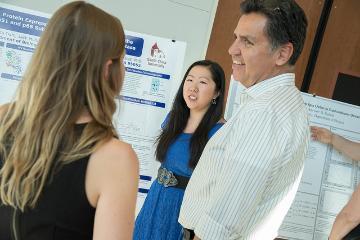
Protein Expression Studies: Co-Expression of the p51 and p66 Subunits of HIV Reverse Transcriptase
Amanda Dahl, Jack McBride, Carlo Armijo, Nicole Mattson
Faculty Mentor: Ángel Islas
Retroviruses use reverse transcription to replicate their genetic material, RNA, and turn it into DNA. The enzymes responsible for this reaction are therefore called reverse transcriptases; Human Immunodeficiency Virus (HIV) is typical of this family of retroviruses in possessing its own reverse transcriptase (HIV-RT), which it uses with its RNA genome to replicate itself in infected T- helper cells. The focus of this study was to express p51 and p66—the two subunits that comprise HIV-RT— and optimize expression conditions under which p51 and p66 will fold together, forming a physiologically relevant heterodimer. The proteins can then be tested further and possible inhibitors of HIV-RT analyzed. There are three primary ways to approach HIV-RT protein expression and purification with the goal of achieving dimerization: 1) co-express p51 and p66 from one plasmid under the control of a single bacterial expression operon, lyse the cells, then purify; 2) express p51 and p66 each from an individual plasmid, lyse the cells, purify the proteins individually, and then combine the purified samples; and 3) express p51 and p66 each from an individual plasmid, lyse the cells, mix the cell pellets together, and then purify. Expression using all three methods has been successful and current efforts focus on examining protein folding and formation of the heterodimer. Native PAGE gels, protein cross-linking with formaldehyde, and gel filtration chromatography methods have all been used to test for formation of the heterodimer, however, gel filtration chromatography appears to be the most promising method.